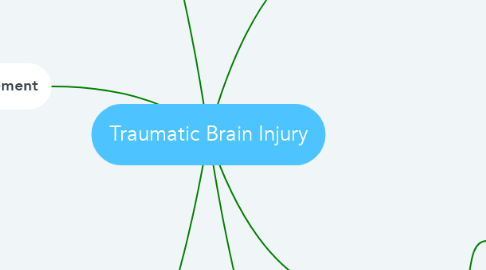
1. Epidemiology
1.1. The National Center for Injury Prevention and Control has published data on TBI-related ED visits, hospitalizations, and deaths in the United States during 2013
1.1.1. Males had higher rates of TBI (959 per 100,000) than females (811 per 100,000), as is true for other categories of traumatic injury
1.1.2. The highest rates of TBI were observed in older adults (≥75 years; 2232 per 100,000 population), very young (0 to 4 years; 1591 per 100,000), and young adults (15 to 24 years; 1081 per 100,000).
1.1.3. TBI can lead to several pathologic injuries, most of which can be identified on neuroimaging
1.1.3.1. ● Skull fracture
1.1.3.2. ● Epidural hematoma (EDH)
1.1.3.3. ● Subdural hematoma (SDH)
1.1.3.4. ● Intraparenchymal hemorrhage
1.1.3.5. ● Cerebral contusion
1.1.3.6. ● Intraventricular hemorrhage
1.1.3.7. ● Focal and diffuse patterns of axonal injury with cerebral edema
1.1.4. The most common mechanisms of TBI, adjusted for age, were falls (413 per 100,000), being struck by an object (142 per 100,000), and motor vehicle crashes (122 per 100,000).
2. Type
2.1. Clinical severity scores
2.1.1. TBI has traditionally been classified using injury severity scores; the most commonly used is the Glasgow Coma Scale (GCS)
2.2. Neuroimaging scales
2.2.1. ● Subarachnoid hemorrhage (SAH)
2.3. Other considerations
2.3.1. Extracranial injuries are present in approximately 35 percent of cases [24]. Multiple systemic traumatic injuries can further exacerbate brain injury because of associated blood loss, hypoxia, and other related complications.
2.3.1.1. Different disease mechanisms (eg, closed versus penetrating injuries, blast versus blunt trauma) may affect the type of pathologic brain injury.
3. Risk factors
3.1. Age
3.1.1. Individuals between the ages of 15 and 24 years
3.1.2. Individuals age 75 and older
3.1.3. Children age five and younger are also at a higher-than-average risk. According to the National Pediatric Trauma Registry, more than 30,000 children are permanently disabled each year as a result of brain injuries.
3.1.4. The greatest risk occurs from mid-afternoon to early evening, and during weekends and the summer months. Children are especially at risk after school. Nearly half (42.6 percent) of all children's injuries occur in roads, 34.3 percent occur at home, and 6.6 percent occur in recreation areas.
3.2. Sex
3.2.1. TBI occurs twice as often in men as in women.
4. Menagement
4.1. Hemodynamic management
4.1.1. Fluids
4.1.2. Blood pressure
4.1.3. Cerebral perfusion pressure
4.2. Ventilation
4.3. Management of coagulopathy
4.4. Temperature management
4.5. Paroxysmal sympathetic hyperactivity
4.6. Nutritional support
5. Clinical Features
5.1. Acute symptoms and signs
5.1.1. The hallmark symptoms of concussion are confusion and amnesia, sometimes with, but often without, preceding loss of consciousness. These symptoms may be apparent immediately after the head injury or may appear several minutes later
5.2. Seizures
5.2.1. Early post-traumatic seizures are those that occur within the first week after head injury. These seizures are considered to be acute symptomatic events and not epilepsy. Posttraumatic seizures occur in less than 5 percent of mild or moderate TBI, and they are more common with more severe TBI, especially if complicated by intracranial hematoma.
5.3. Venous thromboembolism prophylaxis
5.4. Complicated concussion
5.4.1. With uncomplicated, mild TBI, limited structural axonal injury may be present but not overtly evident on computed tomography (CT) or routine conventional magnetic resonance imaging (MRI). However, mild TBI can be complicated in 6 to 10 percent of cases by existent cortical contusions and the development of intracranial hemorrhage, which may be intracerebral, subdural, epidural, or subarachnoid.
